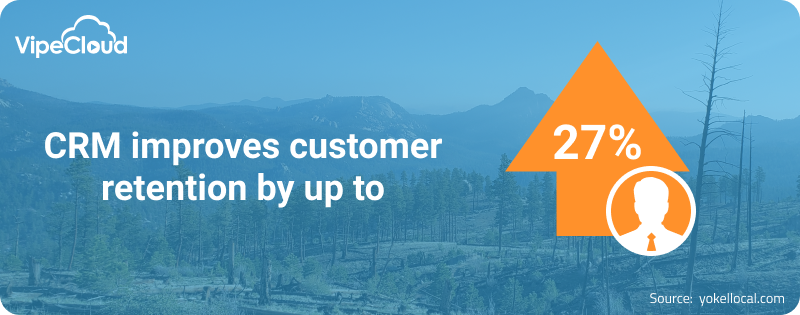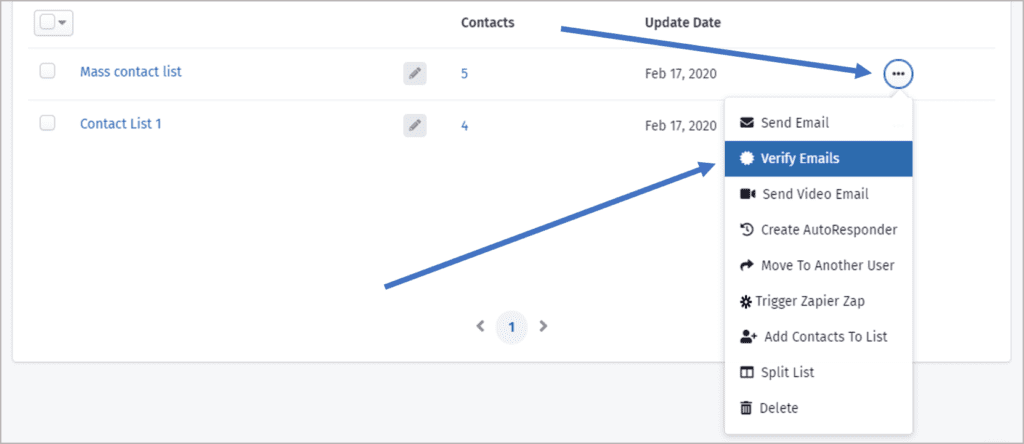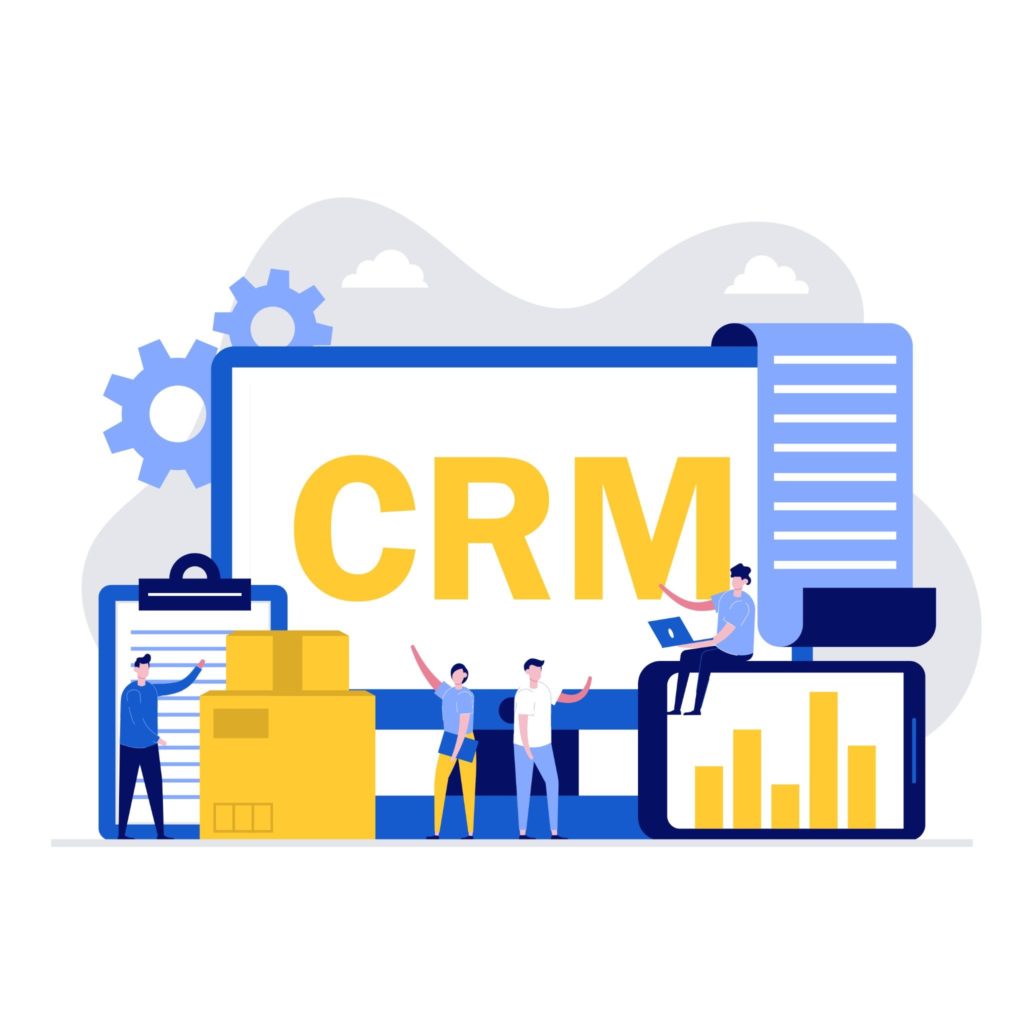Last updated on August 3rd, 2023

In this guide, you’ll gain a complete understanding of what an email marketing CRM is capable of and how to formulate a plan to nurture and expand your audience.
CRM (Customer Relationship Management) has surged in popularity thanks to its many business functions. (CRM usage across all industries went up from 56% in 2018 to 74% in 2019.)
One of the cornerstones of a robust CRM system is how well it handles your email marketing needs.
Some businesses have their CRM and email marketing software separate.
However, businesses looking to consolidate their data and tech stack should strongly consider using an all-in-one email marketing CRM to marry these two essential business functions.
Table of contents:
- What Is CRM Email Marketing?
- How Is An Email Marketing CRM Useful?
- What Are Key Features In An Email Marketing CRM & How Are They Used Best?
- What Would Be A Good Email Marketing CRM Strategy?: Steal These 8 Big Ideas
- How Do I Know If My Email Marketing Strategy Is Working?
- What Is The Best CRM For Email Marketing?

VipeCloud is the only Automation tool your small business needs to
be the hero to your customers.
With Email, Texting, Social, Suites, Chat, Stories, Video Email & Sign Up Forms fully built-in, we provide you with the perfect platform to grow your business.
15 Day Free Trial – Get started risk free. No CC needed.
What Is CRM Email Marketing?
CRM Email Marketing is when you leverage CRM technology to create email campaigns that are made to inform, nurture, and convert your leads or customers.
This includes email automation features like drip campaigns that save you time and can be triggered based on audience interest and behavior. For instance, if a lead signs up for one of your forms, they can be nurtured with a series of pre-crafted emails.
Email marketing CRMs let you easily track the customer journey and see engagement tracking metrics like open rates and cadences, clicks, downloads, and replies.
Here are 3 big reasons why an email CRM system could be useful for you.
How Is An Email Marketing CRM Useful?
Personalized Customer Experiences
CRM has been proven to improve customer retention by up to 27%.

The big picture with CRM is that it helps you “meet customers where they are.”
From lead conversion to customer service, leveraging CRM helps solve things that the customer needs, which helps harmonize the business and customer relationship.
When you combine CRM with email marketing, you can send emails that have a personalized touch to the customer, strengthening their view of your company.
For instance, sending educational material to your MQLs (marketing qualified leads that were qualified using lead scoring) can be what causes some leads to book a call with you.
When the customer journey is in mind, your emails are more relevant to your leads and customers. This, in turn, will lead to more conversions and sales.
Consolidates Your Email Tool, So You Spend Less
The amount of email marketing tools on the market are vast.
Pricing models for these tools vary based on your needs: emails sent per month, amount of seats on your account, and other requirements.
When you adopt an email marketing CRM, your costs get cut down because you integrate software together, plus, there are fewer restrictions and paywalls to go through (on average) as your business scales and increases its email marketing needs.
With less money spent, you can invest the saved capital into other parts of your business over time.
Key Features In An Email Marketing CRM & How To Use Them
Email Autoresponders
This tool automatically sends emails or launches multi-step workflows. It’s ideal for when you need to send emails at scale or at a specific timeframe.

Here are some great use-cases when you use VipeCloud’s AutoResponders tool:
Adding A New Contact – Trigger an email series when a new contact gets added to your CRM. This can be a 3-step welcome email that offers free information or even an onboarding campaign for new clients.
Sign-up Form Workflows – Personalize your AutoResponder emails by sending them from your personal, professional email address rather than your company’s. Use the information from your submitter’s sign-up form (their name, company, etc.) and add time delays to make your follow-up emails effective and non-robotic.
Recurring Emails – Schedule emails to trigger when you need monthly reminders, great for monthly client calls, sales team meetings, and other internal or external company due dates.
Analytics & Engagement Tracking
These are metrics that track the success of your email campaigns. You’ll usually get an overview of the following, just to name a few:
- Email opens
- Link clicks
- Replies
- Bounces
- Unsubscribers
These will be the data points that tell you why some of your follow-up email campaigns are succeeding and why others aren’t.
For instance, if your open rates are low, it’s a telltale sign that either your subject line could need some tweaking. Or your audience is too broad for what you’re offering, thus they need to be segmented.
Templates
Email templates give you a starting point for crafting beautiful emails that gain attention. Great email templates should come in multimedia form (text, images, or video) so you can deliver dynamic marketing that stands out.

Look for functionality that allows you to share your best templates with your staff so that email marketing ideas can be seen and approved faster, all from your CRM.
This is great for ensuring that your team members don’t miss information.
VipeCloud’s drag and drop template builder lets you create your own templates or choose from 600+ pre-built ones.
List Segmentation
List segmentation helps you create the necessary personalized customer experiences we mentioned earlier. This is when you put your contacts in different categories so you can email them relevant materials related to what they care about.
Here are some use-cases for list segmentation:
- Segmenting by Industry
- Segmenting by geography
- Segmenting by their position in your opportunities pipeline
- Segmenting by the forms they submitted
Pro-Tip: With your contact lists constantly changing, look to update them and implement email verification to ensure your emails are arriving at the right person and your email sender score is protected.
How To Create An Email Marketing CRM Strategy: Steal These 8 Big Ideas
1. Set Email Marketing Goals
Your email marketing strategy should start off with what you intend to accomplish:
- Is it more leads?
- More sign-ups for your offer using your email list?
- More website purchases?
Whatever the conversion is, think of the number of conversions you want and set a timeframe for accomplishing it. The first few weeks of your email marketing strategy should be a testing phase where you get an idea of your KPIs (email marketing metrics) and tweak your approach.
2. Always Test & Improve Your Offer(s)
Different offers will resonate with different people. So if you’re looking to convert your email list on your product, think of different ways to make your product a “no-brainer” purchase.
You can add temporary discount incentives, free additions if they sign up in a certain timeframe, and more.
Whether B2B or B2C, segment your email recipients when testing different offers.
Here’s why:
It’s usually rare to strike gold with just the first email you send. So think of dividing your lists by contact behavior (sign-ups, pipeline activity) or demographic (job titles, age, and geography).
Remember that the segmentation should make sense. For instance, if you’re a coach doing live training in Texas, creating a list of your Texas subscribers to send email reminders would work perfectly.
Lastly, Your email list size also plays a role in the success of your offer.
If your list is relatively small (less than 2,000 recipients), you don’t want to overly mention the same offer, as it will have diminishing returns even if it was doing well from the start.
3. Utilize Email Marketing Templates From Your CRM
As we mentioned earlier, email templates help you make your messages more visually appealing.
When creating your campaigns, think of alternating from plain text emails to emails with graphics, colors, and other types of imagery. This will keep your emails interesting and invite recipients to read the entire thing.
4. Speak To The Desires & Pain Points Of Your Audience
All your email marketing campaigns should explain how you’re solving a pain or need for your audience.
Why?
Put simply, it’s what grabs attention, and it’s what will get people to convert.
You can figure out your market’s desires, needs, and pain by doing market research, speaking with your customers, and watching industry trends.
After speaking with prospects on your discovery calls, add some notes about their pain points in the “notes” section of their contact in your CRM. This way, you can revisit it in the future.
As you collect information about the situation of your leads, you can find commonalities across multiple prospects and talk about your solution to them in your emails.
Speaking to your email contacts’ desires and pain points, all starts in your subject line.
A study showed that 64% of email recipients open emails just based on the subject line.
The better your subject line, the higher your open rates (on average), and the better the chance your other email metrics engagements increase (clicks, downloads, etc.).
5. Verify Your Emails Periodically
With more and more users using email for spam, email systems like Gmail are cracking down on suspicious senders.
As a marketer, to not be put in with the “suspicious bunch,” you want to verify the emails you’re sending. This will allow you to ensure your emails are not only delivering, but your sending reputation remains intact.
The upside is that VipeCloud has already created a robust email verification tool to help you verify emails in bulk, saving you time and headaches.

Here are just 5 telltale signs that you need to verify your emails:
- A high percentage of bounces
- A high amount of unsubscribes
- You’ve scraped your list from the web
- You’ve purchased a contact list from a third party
- You’re generally unsure about the quality of your list
6. Find Your Email Cadence Sweet Spot
A cornerstone of your email marketing strategy should be your email cadence. This is the frequency in which you send emails.
You should test out different cadences until you find the sweet spot for your audience.
For example, you could start with just 1 email a week and then slowly rev it to 3 as your audience engages with them more.
Generally speaking, B2C companies will send more emails than B2B because their sales cycles are a lot shorter on average (usually due to lower-ticket products).
If you’re creating drip campaigns, consider adding time delays between emails to give your recipients time to do an action.
7. A/B Test Your Campaigns
In email marketing, A/B testing is when you send different variations of an email to 2 halves of a list or two entirely different lists.
Earlier, we mentioned the power of A/B testing your offer…
But this applies to your emails in general.
Here’s what I mean:
A/B testing copy, templates, and audiences will give you a leg up on finding what works. A/B testing should begin on your lead capture forms, which should segment your form submitters into different lists you can contact.
Keep this in mind too:
A/B test one thing at a time as this will help you isolate conversion variables. For example, making your CTA a blue button vs. just a simple link.
If you A/B test too many things, it’ll be harder to determine what changes made the difference in the result.
8. Mix Things Up
CRM email marketing offers a lot of useful tools to help your campaigns succeed.
Always be open to trying new ways of doing things (exploring your CRM’s capabilities goes a long way.)
Things like using video email marketing could be the new angle your emails need to bring better results.

Mixing things up as time goes on ensures you have more strategies under your belt when other strategies “dry up.”
How Do I Know If My Email Marketing Strategy Is Working?
When incorporating the above email marketing CRM ideas into your strategy, here are a few ways to tell if it’s successful:
- More conversions on your offer
- Improved metrics compared to before
- More sales revenue on the back-end (from emails) than just relying on front-end purchases like ads. (This allows you to invest more into paid ads as long as you’re profitable.)
- Higher customer satisfaction
What Is The Best CRM For Email Marketing?

Are you looking for a CRM email marketing tool?
VipeCloud’s Marketing Suite is built to fit your email marketing needs, from sign-up forms, templates, and automation tools to contact segmentation and even video marketing.
Safely store the information of your most valuable customers and market to them in a way that puts them first.
If you’d like to learn more, request a demo with one of our experts today.
Ready to get started? Try it out for a free 15-days!

Leave a Reply